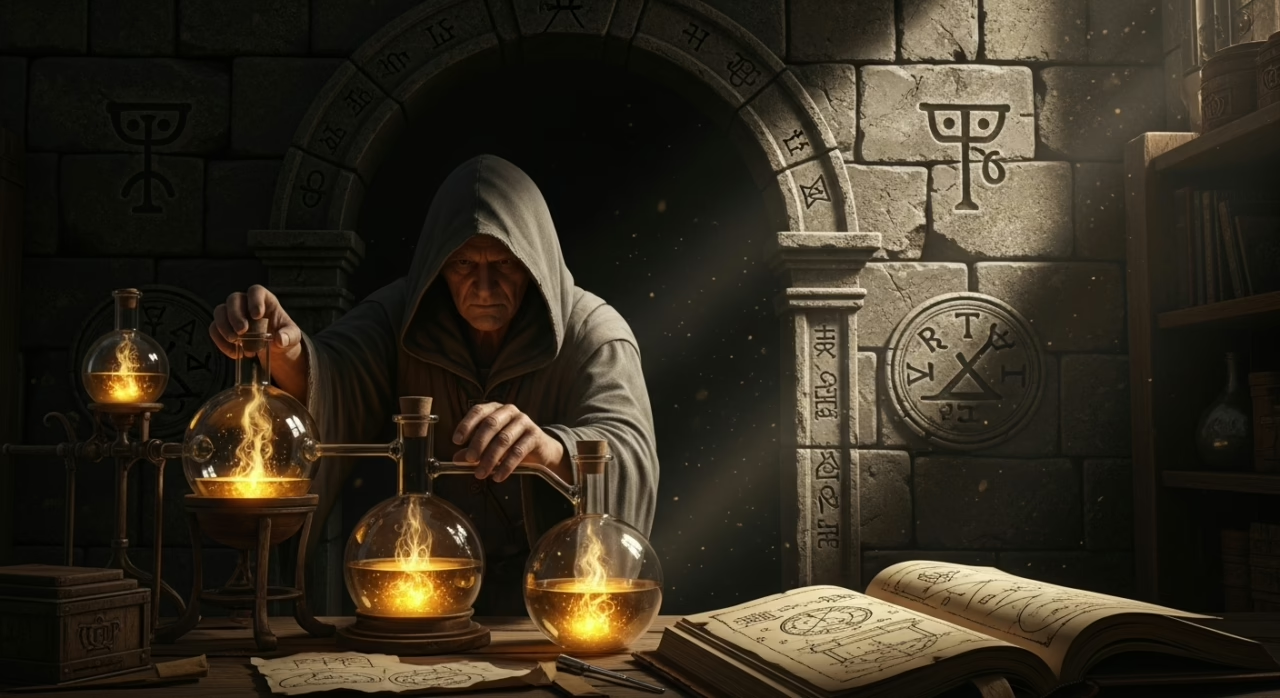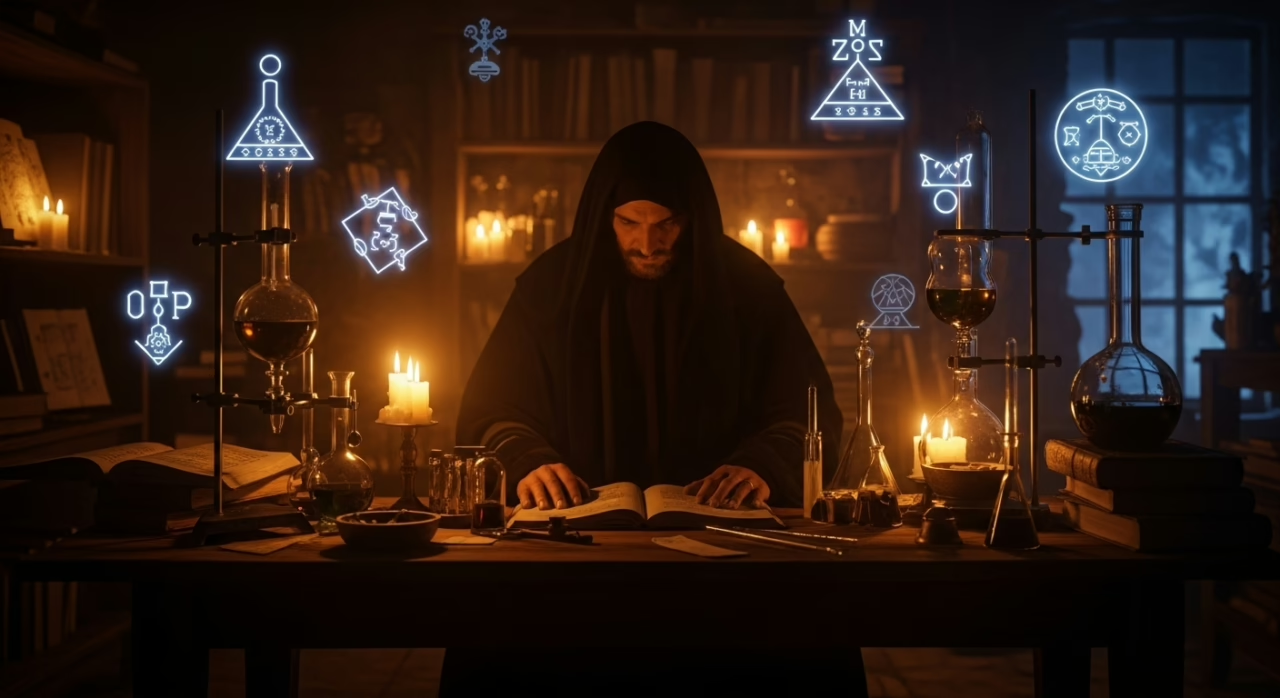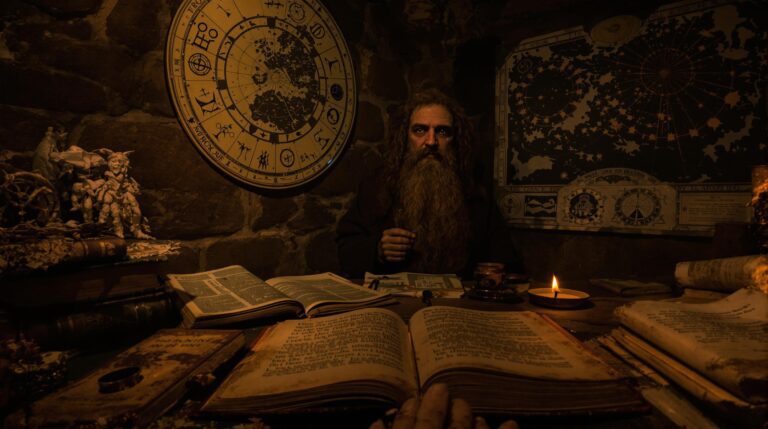Fulcanelli: The Mysterious Alchemist

Fulcanelli: Secrets of the Legendary Alchemist – Few figures in esoteric history evoke such profound mystery as Fulcanelli, the 20th-century alchemist whose identity remains concealed behind pseudonymity.
His seminal works on Gothic cathedrals and philosophical dwellings revealed an architectural language of hermetic wisdom, allegedly hidden in plain sight for centuries.
Scholars continue to debate whether Fulcanelli was a singular adept or a collective entity representing an underground alchemical tradition.
The peculiar circumstances of his manuscripts’ publication, coupled with claims of his alchemical success, tantalize researchers with possibilities extending beyond conventional historiography.
Key Takeaways
Hide- Fulcanelli was an enigmatic 20th-century alchemist whose identity remains unknown despite publishing influential works on alchemy.
- His major works include "Le Mystère des Cathédrales" (1926) and "Les Demeures Philosophales" (1930), both revealing alchemical symbolism in architecture.
- Possible identity candidates include Jules Violle, Jean-Julien Champagne, Pierre Dujols, and Eugène Canseliet.
- Fulcanelli mysteriously disappeared from Paris in 1926, adding to the legend surrounding his persona.
- His writings catalyzed renewed interest in alchemy by interpreting medieval symbolism and connecting ancient wisdom to modern thought.
Who Was Fulcanelli?
Fulcanelli, considered one of the 20th century‘s most enigmatic alchemical figures, published influential works while maintaining absolute anonymity—a feat that has generated decades of speculation about his true identity.
Numerous theories propose candidates ranging from French physicist Jules Violle to artist Jean-Julien Champagne, though compelling evidence for any single identification remains elusive.
His profound impact on modern alchemy persists through his meticulously documented texts, particularly “Le Mystère des Cathédrales” and “Les Demeures Philosophales,” which continue to inspire researchers and practitioners who pursue the philosophical dimensions of alchemical tradition.
The Elusive Identity of Fulcanelli
The historical record of Fulcanelli remains conspicuously thin, with his first documented appearance occurring in Parisian esoteric circles during the 1920s, shortly before the publication of his seminal work “Le Mystère des Cathédrales” in 1926.
Numerous theories regarding his true identity have emerged over the decades, with prominent candidates including the chemist Pierre Dujols, the painter Jean-Julien Champagne, and even Eugène Canseliet himself, who claimed to be merely Fulcanelli’s disciple.
The persistent anonymity of this alchemical adept, maintained despite intensive scholarly investigation, serves as both a frustration to historians and a fitting manifestation of the hermetic tradition‘s emphasis on secrecy and transcendence of personal identity.
Historical records and first appearances
Despite extensive efforts by scholars and occult researchers, historical records concerning Fulcanelli remain frustratingly sparse, with his first documented appearance occurring only in the early 1920s Parisian esoteric circles.
Archival research reveals three significant milestones:
- Introduction to Eugène Canseliet, who became his devoted disciple
- Circulation of alchemical manuscripts among select intellectuals
- Publication of “Le Mystère des Cathédrales,” which synthesized ancient traditions into revolutionary esoteric writings of historical significance
Popular theories about his true identity
While numerous individuals have been proposed as candidates for Fulcanelli’s true identity over the decades, scholarly consensus remains elusive, with each theory offering tantalizing evidence yet falling short of definitive proof.
Secretive societies have guarded his cryptic writings, while mysterious manuscripts and hidden alchemical texts continue to surface, connecting Fulcanelli to legendary alchemists through linguistic anomalies and obscure historical references.
Fulcanelli’s Influence on Alchemy
Fulcanelli, despite—or perhaps because of—his shadowy existence, catalyzed a remarkable revival of interest in alchemical traditions during the early twentieth century.
His seminal works, particularly “Le Mystère des Cathédrales” and “Les Demeures Philosophales,” transcended mere historical curiosity to establish alchemy as a legitimate philosophical framework worthy of serious consideration by modern thinkers.
Through his meticulous interpretations of medieval architectural symbolism and his apparent mastery of alchemical processes, Fulcanelli created an intellectual bridge between ancient wisdom and contemporary esoteric thought, influencing generations of scholars who continue to examine the intersection of science, spirituality, and symbolic knowledge.
Revival of interest in alchemical traditions
During the mid-twentieth century, a profound revival of interest in alchemical traditions emerged within esoteric circles, catalyzed considerably by the enigmatic works attributed to Fulcanelli.
This alchemy revival transcended mere historical curiosity, evolving into philosophical exploration that liberated modern practitioners from materialist constraints.
- Rediscovery of forgotten manuscripts sparked academic reappraisal
- Integration of esoteric traditions with contemporary scientific paradigms
- Cross-cultural examination of alchemical symbolism beyond European contexts
Contribution to 20th-century esoteric thought
Profundity, rather than mere influence, characterizes Fulcanelli’s impact on twentieth-century esoteric thought, reshaping how modern occultists conceptualized the ancient art of transmutation.
His meticulous decoding of alchemical traditions and esoteric symbolism illuminated pathways to spiritual transformation that transcended mere chemical processes.
Through hidden knowledge embedded within architectural forms, Fulcanelli’s mystical practices reintroduced authentic alchemical wisdom to a materialistic age desperately seeking metaphysical liberation.
Exploring Fulcanelli’s Major Works
Fulcanelli’s literary legacy centers on two seminal works that transformed alchemical scholarship in the early twentieth century.
“Le Mystère des Cathédrales” (1926) revolutionized interpretations of Gothic architecture by revealing the encoded alchemical symbolism within Europe’s great cathedrals, particularly Notre-Dame de Paris.
His second masterpiece, “Les Demeures Philosophales” (1930), extended this esoteric analysis to various historical dwellings and monuments, establishing these structures as repositories of hermetic wisdom deliberately preserved in stone by medieval adepts.
“Le Mystère des Cathédrales”
In his seminal work “Le Mystère des Cathédrales,” Fulcanelli proposes that medieval cathedrals serve as stone textbooks of alchemical wisdom, their façades and architectural elements encoding esoteric knowledge intelligible only to initiates.
The Gothic cathedral, according to his analysis, represents not merely religious devotion but a complex symbolic language wherein gargoyles, rose windows, and portal sculptures contain cryptographic instructions for the Great Work of transmutation.
Through meticulous examination of architectural details at Notre-Dame de Paris and Amiens Cathedral, Fulcanelli reveals how master builders embedded a hermetic vocabulary within Christian iconography, thereby preserving ancient wisdom beneath ecclesiastical approval.
Decoding symbols in medieval architecture
When examining “Le Mystère des Cathédrales,” one encounters a revolutionary hermeneutic system through which Fulcanelli deciphered the symbolic language encoded in medieval architecture.
His analysis revealed how gothic motifs concealed esoteric interpretations through spiritual geometry.
- Medieval symbolism operated as a visual language for initiates
- Architectural secrets preserved alchemical knowledge across centuries
- Cathedral elements functioned as deliberate repositories of hermetic wisdom
Hidden meanings in Gothic cathedrals
The grand Gothic cathedrals of medieval Europe stand as more than architectural marvels; they function as elaborate stone encyclopedias encoding alchemical wisdom, according to “Le Mystère des Cathédrales.”
Expanding upon his analysis of symbolic language in medieval structures, Fulcanelli guides readers through Notre Dame de Paris, Amiens Cathedral, and other Gothic monuments, pointing to specific sculptural elements—gargoyles, tympanums, and seemingly decorative motifs—that convey hermetic teachings to the observant initiate.
“Les Demeures Philosophales”
In “Les Demeures Philosophales,” Fulcanelli extends his esoteric analysis beyond cathedrals to examine the alchemical significance embedded within châteaux, mansions, and other historical edifices across France.
The text meticulously decodes architectural elements—from decorative motifs to structural designs—revealing how master builders concealed hermetic wisdom within seemingly ordinary constructions, accessible only to those versed in alchemical language.
Through detailed examination of sites like Jacques Coeur’s palace in Bourges and the Lallemant mansion, Fulcanelli illuminates how these “philosophical dwellings” functioned as three-dimensional manuscripts preserving ancient knowledge through symbolism rather than explicit text.
Insights into alchemical symbolism and wisdom
Published in 1930, “Les Demeures Philosophales” stands as Fulcanelli’s most thorough exploration of architectural symbolism and its profound alchemical significance.
Within its pages, Fulcanelli decodes centuries of philosophical knowledge embedded in stone, revealing:
- Historical contexts where alchemical practices manifested architecturally
- Symbolic interpretations of gargoyles, façades, and cathedral ornaments
- Mystical experiences accessible through proper understanding of these philosophical dwellings
Secrets encoded in historical buildings
While architectural historians often focus on structural innovations and aesthetic developments, Fulcanelli’s “Les Demeures Philosophales” reveals an entirely different dimension: buildings as deliberate repositories of arcane knowledge.
His mystical interpretations disclose encoded messages within architectural symbolism, suggesting secret histories intentionally preserved in stone.
Cathedrals, chateaux, and public monuments emerge as alchemical architecture—texts written in granite, awaiting the initiated reader.
Alchemical Secrets and Symbolism
Fulcanelli’s writings reveal an intricate system of alchemical language, deliberately obscured to protect sacred knowledge while communicating to initiates through metaphor and symbolic correspondence.
The philosopher’s stone—that elusive catalyst for both metallurgical transmutation and spiritual transformation—stands as the central mystery in his texts, described not merely as a physical substance but as the culmination of a precise sequence of operations governed by cosmic timing.
Through architectural symbolism at Gothic cathedrals, particularly Notre Dame de Paris, Fulcanelli demonstrated how medieval craftsmen encoded alchemical secrets in stone, preserving an ancient tradition of wisdom that transcended conventional historical and religious boundaries.
The Language of Alchemy
Fulcanelli’s alchemical writings, cloaked in seemingly impenetrable symbolic language, challenge modern readers to unravel multiple layers of meaning beyond mere chemical processes.
His deliberate use of hermetic symbolism—particularly in “Le Mystère des Cathédrales”—transforms Gothic architecture into a stone lexicon where gargoyles, rose windows, and architectural elements function as encoded repositories of esoteric knowledge.
The significance of this symbolic framework extends beyond medieval obscurantism; it represents a transmission system designed to preserve ancient wisdom through initiatory revelation rather than direct exposition, requiring scholars to approach the text not as mere readers but as intellectual archeologists reconstructing fragmented cosmological systems.
Deciphering Fulcanelli’s symbolic language
The language of alchemical texts has long represented one of the most formidable barriers to understanding esoteric knowledge, and nowhere is this linguistic labyrinth more intricate than in the works attributed to Fulcanelli.
His mystical language employs alchemical metaphors and esoteric symbolism that require multilayered decoding approaches:
- Architectural references encoding hidden messages
- Phonetic cabala and symbolic interpretations
- Deliberate obscuration through terminological ambiguity
Significance of hermetic symbolism
Hermetic symbolism, central to understanding the cryptic writings attributed to Fulcanelli, unfolds through a labyrinthine system of correspondences between material substances and cosmic principles.
These alchemical imagery and symbolic language operate according to hermetic principles where visible signs conceal transformative processes of nature and consciousness.
The initiated few, through patience and intuition, reveal esoteric knowledge that remains forever hidden from the uninitiated observer.
The Philosopher’s Stone and Transmutation
At the heart of Fulcanelli’s alchemical teachings rests the Philosopher’s Stone, which he described not merely as a substance capable of transmuting base metals into gold, but as the embodiment of philosophical perfection.
According to eyewitness accounts, particularly from Eugene Canseliet, Fulcanelli performed successful transmutations before carefully selected observers, transforming lead into gold through procedures detailed in his cryptic writings.
These alleged demonstrations, occurring primarily in the early 20th century, have neither been conclusively verified nor dismissed by modern science, leaving Fulcanelli’s claimed mastery of transmutation suspended between historical anecdote and alchemical legend.
Fulcanelli’s perspectives on alchemical gold
Central to Fulcanelli’s alchemical philosophy stands the concept of gold—not merely as a precious metal coveted for its monetary value, but as a profound metaphysical principle representing perfection and spiritual illumination.
His esoteric practices transcended conventional transmutation theories, positioning alchemical gold as:
- The culmination of mystical transformation
- A metaphor for enlightened consciousness
- The quintessential expression of alchemical processes
Alleged practical demonstrations of transmutation
Several alleged demonstrations of transmutation have been attributed to Fulcanelli, though concrete evidence remains elusive.
Among these accounts, witnesses claimed to have observed base metals transformed into gold through his application of transmutation theories within controlled alchemical experiments.
The historical context of these demonstrations remains shrouded in mythical elements, though some scholars suggest practical applications may have involved sophisticated metallurgical techniques rather than supernatural transformation.
Connections to Secret Societies
Fulcanelli’s esoteric knowledge suggests connections to various occult organizations operating beneath European society’s visible structures during the early twentieth century.
Historical records indicate several meetings between the enigmatic alchemist and prominent figures within Rosicrucian, Masonic, and Martinist circles, though the extent of his formal affiliations remains contested by scholars.
His transmission of alchemical wisdom apparently followed clandestine pathways established by these secret societies, whose influence extended through intellectual salons and specialized publishing houses that propagated hermetic teachings among carefully selected initiates.
Fulcanelli and the Occult Underground
Fulcanelli’s shadowy influence extended beyond his alchemical writings into the labyrinthine world of occult fraternities, though concrete evidence of his affiliations remains tantalizingly elusive.
Historians have traced tenuous connections between the enigmatic alchemist and several esoteric orders, including possible ties to Rosicrucian circles and remnants of the Compagnonnage tradition.
His philosophical framework, particularly his interpretations of architectural symbolism, continues to resonate within contemporary esoteric societies, where his works are studied as foundational texts despite—or perhaps because of—the persistent mystery surrounding their author.
Alleged affiliations with secret groups
Though shrouded in historical ambiguity, the connections between Fulcanelli and various esoteric organizations represent one of the most intriguing aspects of the alchemist’s shadowy legacy.
Primary sources suggest three significant mystical affiliations:
- Possible initiation into Hermetic orders preserving ancient alchemical traditions
- Rumored involvement with Rosicrucian circles operating across interwar Europe
- Alleged connections to occult societies safeguarding esoteric practices beyond conventional history’s reach
Influence on modern esoteric societies
While numerous occult figures have influenced modern esoteric thought, few have cast as long and enigmatic a shadow as the elusive alchemist whose writings continue to ripple through contemporary mystical organizations.
His alchemical symbols and secret rituals permeate modern mysticism, offering hidden knowledge that many esoteric practices still aim to decipher, making Fulcanelli a perpetual touchstone for those seeking transmutation beyond the material domain.
Encounters and Influences
Fulcanelli’s intellectual circle extended beyond his direct disciples to include notable figures like René Schwaller de Lubicz and possibly members of the Theosophical Society, though specific affiliations remain deliberately obscured in historical records.
Contemporary accounts suggest his sudden vanishing from Paris in 1926 coincided with heightened surveillance of esoteric groups by European authorities, prompting speculation about his retreat into the protection of hermetic brotherhoods.
These mysterious disappearances, documented by his student Eugène Canseliet, parallel similar patterns among historical alchemists who, upon achieving philosophical enlightenment, reportedly withdrew from public life to continue their work in seclusion.
Associations with famous alchemists and philosophers
Beyond the shadowy veil that obscures much of his identity, Fulcanelli maintained significant connections to prominent figures in alchemical circles and secret societies throughout the early 20th century.
His philosophical influences reflect historical alchemy’s mystical connections, evidenced through:
- Correspondence with René Schwaller de Lubicz, whose Egyptian studies paralleled Fulcanelli’s alchemical symbols
- Intellectual exchanges with Eugène Canseliet
- Rumored dialogues with quantum physicist Louis de Broglie
Stories of mysterious disappearances
The mysterious vanishing of Fulcanelli in the late 1920s marks one of the most perplexing episodes in alchemical history, connecting his enigmatic legacy to the labyrinthine networks of secret societies that flourished in interwar Europe.
His disappearance catalyzed numerous unsolved cases of cryptic messages and hidden clues throughout Paris, while alleged spectral sightings continued well into the 1950s, further mythologizing his elusive persona.
Legacy and Continuing Mysteries
Fulcanelli’s legacy extends far beyond his ostensible disappearance in the 1920s, with his writings continuing to influence contemporary alchemical practitioners, esoteric scholars, and numerous scientific thinkers who recognize prescient insights in his cryptic references to nuclear physics.
The mysterious adept has permeated popular culture through references in literature, film, and digital media, where his enigmatic persona serves as shorthand for arcane wisdom and the pursuit of ancient knowledge.
Despite—or perhaps because of—his resistance to simple categorization, Fulcanelli remains a compelling cipher whose work challenges conventional historiography of science, suggesting alternative lineages of knowledge transmission that operate alongside, yet distinct from, recognized academic traditions.
Fulcanelli’s Lasting Impact
Fulcanelli’s legacy extends beyond mere alchemical teachings into the domain of modern esoteric thought, with scholars and occultists continuing to extract new meanings from his cryptic texts nearly a century after their publication.
Contemporary researchers remain divided on fundamental questions about the enigmatic figure—whether he was a single individual or a collective pseudonym, and whether his purported transmutations represented literal chemical processes or symbolic spiritual transformations.
His enduring mystique, bolstered by Jacques Bergier’s claim of a 1937 meeting with the allegedly centuries-old adept, guarantees that investigations into Fulcanelli’s true identity and the authenticity of his alchemical knowledge persist in academic circles and among dedicated enthusiasts worldwide.
Modern interpretations of his teachings
Despite nearly a century of scholarly investigation, modern interpretations of Fulcanelli’s esoteric teachings remain as diverse and contested as the identity of the enigmatic alchemist himself.
Contemporary scholars engage with his alchemical symbolism through:
- Mystical interpretations linking ancient wisdom to quantum physics
- Modern alchemy practices focused on spiritual transformation rather than material transmutation
- Esoteric analyses of architectural symbolism as coded maps to consciousness expansion
Ongoing debates and investigations into his identity
Who precisely authored the cryptic alchemical texts attributed to Fulcanelli remains one of the most enduring mysteries in esoteric scholarship.
Various Fulcanelli theories propose candidates ranging from prominent occultists to obscure scholars, with investigations examining alchemical manuscripts, mystical symbolism, and occult practices within their historical contexts.
This enigma persists despite decades of scrutiny, preserving the allure of hermetic tradition.
Fulcanelli in Popular Culture
Fulcanelli’s enigmatic presence has permeated popular culture, appearing in numerous novels, films, and graphic narratives that exploit his mysterious identity and alleged mastery of transmutation.
Authors and screenwriters, from Umberto Eco to Paulo Coelho, have incorporated Fulcanelli’s arcane knowledge and legendary disappearance as plot devices, crafting narratives that blur historical fact with esoteric fiction.
This cultural fascination with the elusive alchemist reflects a broader societal interest in hidden knowledge and secret histories—a persistent curiosity about whether scientific enlightenment might still accommodate ancient alchemical mysteries.
Portrayal in literature and film
Frequently appearing as an enigmatic figure in popular culture, the mysterious alchemist Fulcanelli has inspired numerous fictional portrayals across literature and film since the mid-twentieth century.
His character archetypes often embody esoteric wisdom and forbidden knowledge in cinematic adaptations and literary representations, embodying narrative themes of:
- Immortality and the transcendence of physical limitations
- Guardian of ancient, transformative secrets
- Cultural symbolism of the eternal seeker of philosophical truth
Cultural fascination with the enigmatic alchemist
Beyond fictional depictions, the shadowy figure of Fulcanelli has catalyzed an enduring cultural fascination that spans intellectual communities, occult circles, and mainstream audiences alike.
His enigmatic disappearance and cryptic writings on alchemical rituals continue to inspire exploration of esoteric symbolism across diverse cultural representations.
Fulcanelli’s philosophy bridges ancient mystical traditions with modern intellectual inquiry, offering liberation through transmutation of consciousness rather than mere material transformation.
Final Thoughts
Fulcanelli’s luminous shadow stretches across the landscape of modern esoteric thought, his earthly departure merely transforming his presence rather than diminishing it.
The veiled master’s enigmatic writings continue to beckon seekers through architectural labyrinths of symbolic wisdom, inviting contemporary minds to decode what lies beneath carved stone.
Perhaps his greatest alchemical feat was transmuting himself into an enduring question—one that illuminates more through its asking than its answer.
- Bergier, J. (1971). Les livres maudits. Robert Laffont.
- Canseliet, E. (1948). Deux logis alchimiques: En marge de la science et de l’histoire. Jean Schemit.
- Canseliet, E. (1964). Préface à l’édition de 1964 de Le Mystère des Cathédrales. Jean-Jacques Pauvert.
- Carroll, R. T. (2003). Fulcanelli and the philosopher’s stone: Alchemy in modern times. The Skeptic Encyclopedia of Pseudoscience, 1, 157–161.
- Chevalier, J., & Gheerbrant, A. (1994). The penguin dictionary of symbols (J. Buchanan-Brown, Trans.). Penguin Books.
- Eliade, M. (1956). The forge and the crucible: The origins and structures of alchemy (S. Corrin, Trans.). University of Chicago Press.
- Faivre, A. (1994). Access to Western esotericism. State University of New York Press.
- Hanegraaff, W. J. (2012). Esotericism and the academy: Rejected knowledge in Western culture. Cambridge University Press.
- McLean, A. (Ed.). (1992). Fulcanelli: Master alchemist: Le Mystère des Cathédrales interpreted. Phanes Press.
- Principe, L. M. (2013). The secrets of alchemy. University of Chicago Press.
- Roob, A. (2001). Alchemy & mysticism: The hermetic museum. Taschen.
- Schmidt, J. M. (2000). Restoring the alchemical tradition: Fulcanelli and the language of the birds. Esoterica, 2, 71–90.
- Trismosin, S. (1982). Splendor solis: Alchemical treatises of Solomon Trismosin. Shambhala Publications.
- Voss, A. (2006). Esotericism and the academy: The transition from the Renaissance to the modern era. Journal of the Western Mystery Tradition, 10(1), 1–18.
- Yates, F. A. (1964). Giordano Bruno and the Hermetic tradition. University of Chicago Press.






